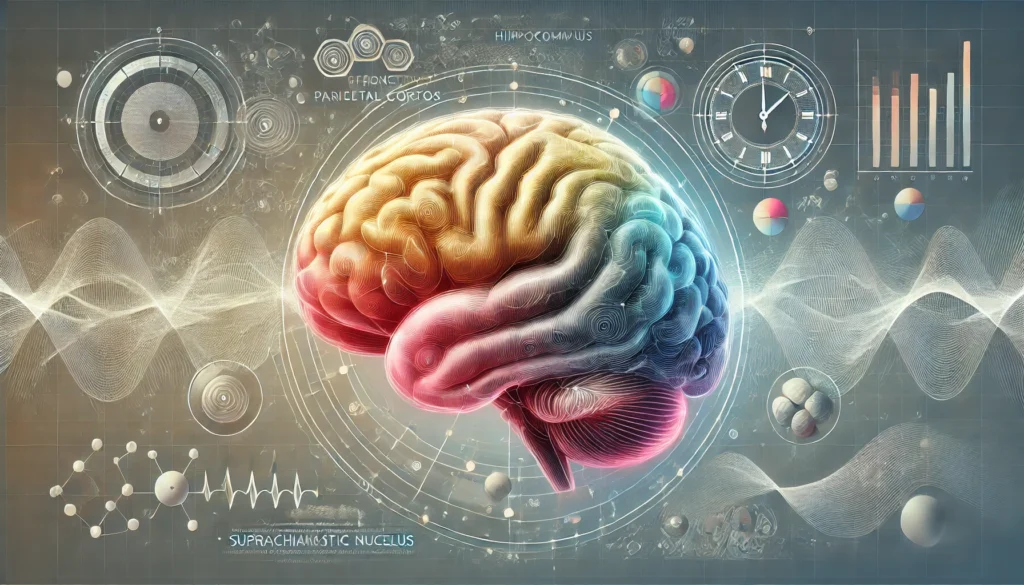Introduction
Time is one of the first mental constructs we learn as children, and ironically, one of the first cognitive domains to deteriorate when dementia begins to take hold. The human experience of time—knowing the date, remembering the season, understanding the difference between morning and night—is deeply tied to memory, spatial awareness, and neurological integrity. For individuals living with dementia, this perception becomes increasingly distorted, leading to a range of challenges commonly grouped under the term “dementia and time confusion.”
You may also like: How to Stop Cognitive Decline: Science-Backed Steps for Prevention and Brain Longevity
When families first notice symptoms, one of the most subtle and perplexing signs is confusion about time. A loved one may insist it is nighttime in the middle of the afternoon or become agitated because they believe they have missed an important appointment that occurred days ago. These episodes of temporal disorientation are not mere memory lapses. They reflect profound neurological changes that affect the brain’s internal clock. Understanding the connection between dementia and confusion about time can help caregivers respond with empathy, clinicians provide better treatment, and families prepare for the road ahead.
This article explores how dementia disrupts time orientation, why this symptom occurs, what it means clinically, and how loved ones can adapt their care approach to better manage the challenges that arise from it.

How the Brain Perceives Time and Why It Matters
Time perception is a cognitive process that relies on several brain regions working in concert. The hippocampus, located deep in the temporal lobe, plays a central role in encoding new memories, while the prefrontal cortex helps us organize those memories into a chronological framework. The parietal lobe helps determine spatial and temporal relationships, such as estimating duration or understanding sequences.
When these regions are damaged or degraded by dementia-related processes—including protein buildup, inflammation, and neuron loss—the result is impaired time perception. This not only affects the ability to remember dates or track time but also disturbs the internal rhythm that governs daily functioning. For instance, someone with dementia might believe they just woke up moments after finishing dinner, or they may think a visit from a grandchild happened minutes ago when it occurred the previous week.
Time confusion can result in poor sleep patterns, wandering at inappropriate hours, agitation during transitions between activities, and emotional distress when expectations don’t match reality. This breakdown in time orientation represents more than a minor inconvenience. It is one of the clearest signs that the brain is losing its ability to construct a coherent narrative of daily life.
Early Signs of Dementia and Confusion with Time
In the early stages of dementia, time confusion often manifests subtly. A person might ask what day it is more frequently or struggle to recall the season. They may write the wrong year on checks or become unsure about upcoming holidays. These seemingly minor mistakes can be brushed off as normal aging until they become persistent.
What sets dementia-related confusion apart is its consistency and impact. While most people occasionally forget the day of the week, someone with early dementia may lose track of entire weeks or fail to connect routine events to a timeline. For example, they might believe they haven’t eaten breakfast even after doing so minutes earlier or get dressed for church on a Tuesday.
Over time, the confusion becomes more pronounced. People may reverse the order of events, believing something happened before it actually did, or recall future plans as past events. These cognitive misfires often stem from impaired memory consolidation in the hippocampus and disruptions in circadian rhythm—the brain’s built-in biological clock.

Dementia and Time Confusion in Daily Life
As dementia progresses, the experience of time becomes increasingly fractured. Individuals may live in a psychological present where past and future blur. For caregivers, this can be emotionally draining and practically challenging. A parent may wake up at 2 a.m. thinking it is morning and attempt to prepare breakfast. They might become distressed when no one shows up for an event they believe is happening now but took place last week.
This kind of disorientation, a key component of dementia and confusion, often leads to patterns of behavior that confuse or alarm family members. Repetitive questioning is common: “What time is it?” or “Is it time to go yet?” These questions aren’t meant to irritate but are reflections of a sincere disconnection from temporal reality. It’s not uncommon for people with dementia to feel trapped in loops of anticipation or regret because their ability to ground themselves in the present has eroded.
Time confusion also affects relationships. A person may refer to their adult children as if they were still teenagers or express surprise at changes in appearance that accumulated over years. These discrepancies are not mere forgetfulness. They reflect the collapse of temporal anchoring that makes social context intelligible.

The Role of Circadian Rhythms and Sleep-Wake Cycles
One of the most overlooked yet crucial elements linking dementia and time confusion is the circadian rhythm. This internal body clock regulates sleep, wakefulness, hormone secretion, and mood. In dementia, especially Alzheimer’s disease, the suprachiasmatic nucleus (SCN) in the hypothalamus—which controls circadian rhythms—becomes damaged. The result is a breakdown in the brain’s ability to distinguish day from night.
The consequences are visible and distressing. Individuals may suffer from “sundowning,” a phenomenon where confusion and agitation intensify in the late afternoon and evening. They might become restless at night, attempt to leave the house, or sleep during the day and stay awake after dark. This disrupted rhythm exacerbates disorientation and contributes to the cycle of dementia and time confusion.
Caregivers can help by reinforcing natural light exposure during the day, establishing calming evening routines, and using timed lighting systems to simulate daylight. Though not a cure, these interventions can stabilize sleep-wake patterns and reduce the emotional volatility caused by circadian misalignment.
Clinical Relevance of Time Confusion in Dementia Diagnosis
While memory loss is the hallmark symptom most associated with dementia, time disorientation is among the earliest and most diagnostically significant signs. Neurologists often include questions about time in cognitive assessments because the inability to correctly identify the date, time of day, or season suggests more than simple forgetfulness. It reflects a deeper cortical dysfunction.
Tests like the Mini-Mental State Examination (MMSE) and the Montreal Cognitive Assessment (MoCA) include orientation questions to gauge time perception. Failure to answer these questions correctly contributes to the diagnostic criteria for conditions like Alzheimer’s disease and other types of dementia.
In more advanced stages, time confusion becomes a barrier to informed consent, medication compliance, and personal safety. Individuals may take multiple doses of a drug thinking they missed one or attempt to leave for appointments days early. Understanding how dementia and confusion intersect at the level of temporal awareness is vital for building an accurate clinical picture and customizing care.
Emotional and Psychological Impact on Patients and Families
Temporal disorientation doesn’t just disrupt logistics; it alters the emotional lives of both the individual and those around them. For the person experiencing dementia and time confusion, every day can feel unpredictable. They may believe they’re late, lost, or forgotten, leading to anxiety, sadness, and even paranoia. When they express urgency or distress, it’s often because their internal clock is signaling a false but emotionally compelling narrative.
For family members, these behaviors can be puzzling and painful. Watching a loved one forget what day it is, misjudge how much time has passed, or react to a phantom schedule creates a sense of helplessness. Misinterpretations can cause conflict, especially if caregivers try to reason with someone who has lost the capacity to anchor themselves in time.
It’s essential for caregivers to validate feelings even if they can’t correct perceptions. Rather than saying, “That appointment isn’t until tomorrow,” they might say, “You’re thinking about something important. Let’s look at the calendar together.” This preserves dignity and provides a shared reference point that can gently redirect without confrontation.

How Technology Can Assist with Time Orientation
In recent years, digital tools have emerged to help mitigate the effects of dementia and confusion about time. Devices such as day clocks, which clearly display the day of the week, time, and part of the day (morning, afternoon, evening), are designed specifically for individuals with cognitive impairments. These clocks reduce stress and repetitive questioning by offering a constant visual reminder.
Other technologies include reminder apps, talking calendars, voice-activated assistants, and wearable trackers that notify users of daily events. When combined with routine-based care, these tools can provide a scaffolding that supports autonomy and reduces dependence on caregivers.
Virtual reality platforms and cognitive stimulation software are also being explored as ways to reinforce time orientation. Some programs guide users through daily routines in simulated environments, helping them retain a sense of sequence and predictability.
Strategies for Caregivers to Support Time Awareness
Managing dementia and time confusion requires a blend of creativity, patience, and structured support. Caregivers can adopt several strategies to help their loved ones navigate temporal disorientation:
Creating visual cues around the home—such as large calendars, whiteboards with daily schedules, and labeled clocks—can make time more tangible. Establishing consistent routines for meals, medications, and sleep can reinforce temporal anchors. Even simple rituals like opening curtains in the morning or dimming lights at dusk help synchronize the internal clock with the external world.
Reassurance is key. Instead of arguing when someone insists it’s time to go to an event that happened last week, validate the emotion behind the confusion. Say, “It sounds like you’re looking forward to that. Let’s talk about it more.” This builds trust and reduces agitation.
Importantly, caregivers must also care for themselves. Time confusion can be exhausting to manage. Support groups, respite care, and professional guidance offer essential outlets for maintaining the stamina needed to support someone through this challenging symptom.
Cultural and Linguistic Considerations in Time Perception
Time perception is not a universal experience. Different cultures understand and value time in diverse ways. In Western societies, time is often linear and segmented—we rely heavily on clocks, schedules, and deadlines. In contrast, many Indigenous, African, and Eastern cultures view time as cyclical or event-based, tied more to natural phenomena or social events than to the ticking of a clock.
This cultural lens affects how dementia and confusion about time are interpreted. In some cultures, not knowing the date may not be perceived as problematic, whereas in others it might be seen as a serious cognitive failure. Understanding these nuances helps clinicians and caregivers offer more respectful and appropriate support.
Language also plays a role. Terms for time vary widely, and in some languages, the future and past may not be grammatically distinct. When evaluating dementia in multilingual or multicultural individuals, it’s crucial to interpret time confusion within the context of their cultural and linguistic background.
Frequently Asked Questions
1. What causes dementia and time confusion?
Dementia and time confusion arise when regions of the brain responsible for memory, sequencing, and circadian rhythm become damaged. The hippocampus, prefrontal cortex, and hypothalamus all play roles in time perception. When dementia affects these areas, individuals lose the ability to maintain accurate orientation to time, leading to disorientation, anxiety, and disrupted routines.
2. How does time confusion differ from regular forgetfulness?
Regular forgetfulness might involve briefly forgetting the day or misplacing an item but being able to recall it later. In contrast, dementia-related time confusion is persistent, more disorienting, and often includes confusion about seasons, years, or the order of events. It’s not just forgetting the day—it’s losing the framework that organizes daily life.
3. Is time confusion an early sign of dementia?
Yes, disorientation to time is often one of the earliest indicators of cognitive decline. Individuals may begin asking about the date frequently, struggle to understand time frames, or misplace events on a timeline. Clinicians include time orientation questions in diagnostic assessments to help identify early dementia.
4. Can medication help with dementia and confusion?
Some medications prescribed for dementia may help slow cognitive decline and stabilize symptoms, including confusion. These include cholinesterase inhibitors and memantine. However, they do not cure dementia and their effectiveness varies. Managing time confusion often involves behavioral strategies and environmental modifications in addition to medication.
5. What is sundowning and how is it related to time confusion?
Sundowning refers to a pattern where individuals with dementia become more confused or agitated in the late afternoon or evening. It is closely related to disrupted circadian rhythms and is a common expression of dementia and time confusion. Managing light exposure, reducing stimulation in the evening, and maintaining consistent schedules can help.
6. How can caregivers respond to repetitive questions about time?
Responding with patience and consistency is key. Using visual aids like clocks or calendars can reduce the need for verbal reassurance. Rather than becoming frustrated, caregivers can redirect or acknowledge the concern behind the question, offering comfort while avoiding correction.
7. Are there tools that help people with dementia keep track of time?
Yes, several tools are designed to assist with time orientation, including large display clocks, talking calendars, and voice assistants. These devices can help individuals understand the current time of day, scheduled events, and routine tasks. When integrated into daily life, they support autonomy and reduce stress.
8. Can cultural views on time affect how dementia symptoms are perceived?
Absolutely. In cultures where time is seen as cyclical or event-driven, disorientation to calendar time may not be viewed as problematic. Care strategies should be culturally sensitive and tailored to how the individual understands and relates to time. This improves communication and ensures respectful care.
9. Why is time confusion distressing for people with dementia?
When a person can’t orient themselves in time, it can create a sense of chaos, urgency, or loss. They may feel as though they’re late, missing something important, or trapped in the wrong moment. These feelings can cause anxiety, irritability, or paranoia, especially if others dismiss their concerns without explanation or support.
10. How can caregivers support healthy circadian rhythms?
Encouraging natural light exposure, maintaining consistent wake and sleep times, limiting naps, and creating calming nighttime routines can all help regulate circadian rhythms. Some caregivers use light therapy or melatonin supplements under medical supervision. Regularity and environmental cues are the foundation for circadian stability.

Conclusion
Dementia and time confusion are not isolated symptoms; they are central to the lived experience of cognitive decline. When someone no longer knows whether it’s morning or night, or misjudges the order of events, it profoundly alters how they interact with the world. These changes disrupt routines, strain relationships, and create emotional upheaval for both patients and caregivers.
By understanding how dementia and confusion about time arise, recognizing the underlying neurological disruptions, and embracing practical tools and compassionate strategies, we can offer better care. Clocks and calendars may seem like simple solutions, but paired with emotional validation and environmental consistency, they become powerful instruments for dignity and stability.
As awareness grows, so too must our commitment to informed, empathetic caregiving. Time, once lost in the fog of dementia, can be partially reclaimed through thoughtful design, patient communication, and a deeper appreciation of the rhythms that govern our lives. In doing so, we bring order to confusion and comfort to those navigating one of life’s most challenging journeys.
Was this article helpful? Don’t let it stop with you. Share it right now with someone who needs to see it—whether it’s a friend, a colleague, or your whole network. And if staying ahead on this topic matters to you, subscribe to this publication for the most up-to-date information. You’ll get the latest insights delivered straight to you—no searching, no missing out.
Further Reading:
Cognitive Brain Damage Symptoms: What They Mean and When to Seek Help



